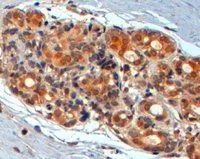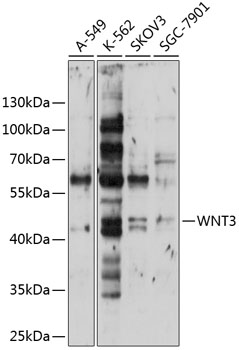
IHC-P analysis of human breast using GTX89319 WNT3 antibody, Internal. Antigen retrieval : citrate buffer pH 6 Dilution : 2microg/ml
Wnt3 antibody, Internal
GTX89319
ApplicationsImmunoFluorescence, Western Blot, ImmunoCytoChemistry, ImmunoHistoChemistry, ImmunoHistoChemistry Paraffin
Product group Antibodies
TargetWNT3
Overview
- SupplierGeneTex
- Product NameWnt3 antibody, Internal
- Delivery Days Customer9
- Application Supplier NoteWB: 1-3microg/ml. IHC-P: 2-4microg/ml. *Optimal dilutions/concentrations should be determined by the researcher.Not tested in other applications.
- ApplicationsImmunoFluorescence, Western Blot, ImmunoCytoChemistry, ImmunoHistoChemistry, ImmunoHistoChemistry Paraffin
- CertificationResearch Use Only
- ClonalityPolyclonal
- Concentration0.50 mg/ml
- ConjugateUnconjugated
- Gene ID7473
- Target nameWNT3
- Target descriptionWnt family member 3
- Target synonymsINT4, TETAMS, proto-oncogene Wnt-3, WNT-3 proto-oncogene protein, proto-oncogene Int-4 homolog, wingless-type MMTV integration site family, member 3
- HostGoat
- IsotypeIgG
- Protein IDP56703
- Protein NameProto-oncogene Wnt-3
- Scientific DescriptionThe WNT gene family consists of structurally related genes which encode secreted signaling proteins. These proteins have been implicated in oncogenesis and in several developmental processes, including regulation of cell fate and patterning during embryogenesis. This gene is a member of the WNT gene family. It encodes a protein which shows 98% amino acid identity to mouse Wnt3 protein, and 84% to human WNT3A protein, another WNT gene product. The mouse studies show the requirement of Wnt3 in primary axis formation in the mouse. Studies of the gene expression suggest that this gene may play a key role in some cases of human breast, rectal, lung, and gastric cancer through activation of the WNT-beta-catenin-TCF signaling pathway. This gene is clustered with WNT15, another family member, in the chromosome 17q21 region. [provided by RefSeq, Jul 2008]
- Storage Instruction-20°C or -80°C,2°C to 8°C
- UNSPSC12352203
References
- Identification of candidate lncRNAs and circRNAs regulating WNT3/beta-catenin signaling in essential hypertension. Yin L et al., 2020 May 11, Aging (Albany NY)Read more






